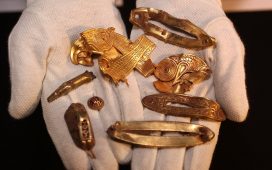King Tutankhamun’s cause of death has been a debate for more than a century, but a DNA analysis has brought experts closer to understanding what killed the boy king.
After analyzing King Tut’s remains, researchers found genetic evidence to suggest he met his untimely end in part due to repeated bouts of malaria.
This mosquito-borne illness is treatable today, but often turned fatal when King Tut more than 3,300 years ago.
Tim Batty, general manager of the Tutankhamun Exhibition, said in January: ‘The tests show that Tutankhamun was infected with malaria that may have killed him.’
The analysis also identified King Tut’s grandparents as the pharaoh Amenhotep III and his queen Tiye, both of whom also died with malaria.
‘It’s another piece of the great jigsaw surrounding the life and death of Tutankhamun,’ said Batty.
A separate DNA analysis concluded that the boy king was a product of inbreeding, which caused him to develop several health conditions that may have contributed to his short lifespan as well.
King Tut ruled Egypt for only nine years before he died at just 18 years old. Though his reign was short-lived, he remains one of the most renowned pharaohs in history mainly due to the sensational discovery of his tomb in 1922.

For more than a century, Egyptologists have debated King Tut’s cause of death. But a DNA analysis has brought them closer to understanding what killed the boy king

A separate DNA analysis concluded that the boy king was a product of inbreeding , which caused him to develop several health conditions that may have contributed to his short lifespan as well. Pictured is a recreation of what King Tut may have looked like
That dig, conducted by British archaeologist Howard Carter, unearthed the boy king’s nearly intact remains along with more than 5,000 artifacts.
Determining a mummified person’s cause of death is difficult due to deterioration of the remains over time and the mummification process itself, which involves removing all organs except for the heart.
But DNA can reveal clues about a mummified person’s health history.
The study, conducted from the National Research Centre, Cairo University’s Faculty of Medicine and two German DNA specialists.
The team took tissue samples from the several mummified remains in 2000 and announced the findings this year.
The results suggested that King Tut was the son of the anonymous mummy in tomb KV55 in the Valley of the Kings. His mother, also anonymous, was possibly buried in tomb KV35.
‘Unfortunately as the mummies in KV55 and KV35 have not been positively identified by conventional archaeological means, they can only be identified by “reverse engineering”, which may suggest that Tutankhamun’s father was the heretic pharaoh Akhenaten,’ researchers shared.
It may still be possible to link Tutankhamun with the mummy in KV55 by DNA, but it is highly unlikely to identify the mummy.

King Tut ruled Egypt for only nine years before he died at just 18 years old. Though his reign was short-lived, he remains one of the most renowned pharaohs in history mainly due to the sensational discovery of his tomb in 1923
‘In addition to genetic information on Tut’s family connections the DNA tests have reveal further information such as diseases and inherited problems that may have afflicted Tutankhamun,’ said Batty.
‘The malaria just adds to the many possible causes of his death.’
A BBC documentary in 2014, titled ‘Tutankhamun: The Truth Uncovered,’ also resurfaced, focusing on a DNA analysis that determined King Tut’s parents were siblings.
Experts have long believed that King Tut was the son of the pharaoh Akhenaten, who is best known for replacing Egypt’s polytheistic religion with a monotheistic faith that worshipped the sun god Aten.
His mother’s identify is still a subject of debate, but scholars generally agree that it is either Queen Nefertiti (Akhenaten’s primary wife) Queen Kiya (one of his sister-wives) or a lesser-known character known as the ‘Younger Lady.’
The Younger Lady is a mummy that was found buried in the Valley of the Kings in 1898. Experts are still unsure of her true identity, but DNA analysis of her remains suggested that she could be King Tut’s mother, and Akhenaten’s biological sister.
‘They turned out that they’re brother and sister, which was a big surprise for us. A lot of incest happened… they didn’t like to let royal and non-royal blood mix, so they tried to keep it within the royal family,’ said study co-author and geneticist Yehia Gad.
The findings were originally published in 2010 issue of the Journal of the American Medical Association (JAMA).
The researchers came to this ‘unexpected’ conclusion after analyzing the DNA of 11 mummies believed to be related to King Tut.
In ancient Egypt, inbreeding was extremely common in royal families. But this practice significantly increased the risk of genetic diseases and birth defects.
‘Several pathologies including Köhler disease II were diagnosed in Tutankhamun,’ the study reads, though ‘none alone would have caused death.’
Köhler disease is a rare bone disorder of the foot in children that restricts blood flow to the bone tissue and causes necrosis.
Further investigation of King Tut’s remains, including CT scans, suggested he indeed had necrosis of the left foot, and several walking canes were found in his tomb.
The researchers identified the combined impact of King Tut’s necrosis and malaria infections as the most likely cause of death.
‘Walking impairment and malarial disease sustained by Tutankhamun is supported by the discovery of canes and an afterlife pharmacy in his tomb,’ they wrote in their report.
But in the years since this study was published, other experts have challenged its findings.
In 2022, French Egyptologist Marc Gabolde said he believed King Tut’s mom was actually Akhenaten’s cousin and chief wife Nefertiti.
Referencing the 2010 study during a talk at Harvard University, Gabolde said the genetic overlap between King Tut’s parents does not necessarily mean they were brother and sister.
It could also have resulted from three back-to-back generations of marriage between first cousins, he explained.
‘The consequence of that is that the DNA of the third generation between cousins looks like the DNA between a brother and sister,’ Gabolde said, according to LiveScience.
‘I believe that Tutankhamun is the son of Akhenaten and Nefertiti, but that Akhenaten and Nefertiti were cousins.’
But Zahi Hawass, the former head of Egypt’s Ministry of Tourism and Antiquities who led the 2010 study, disputed this claim, arguing that it conflicted with the facts shown by his DNA analysis and there was no other evidence to support it.










